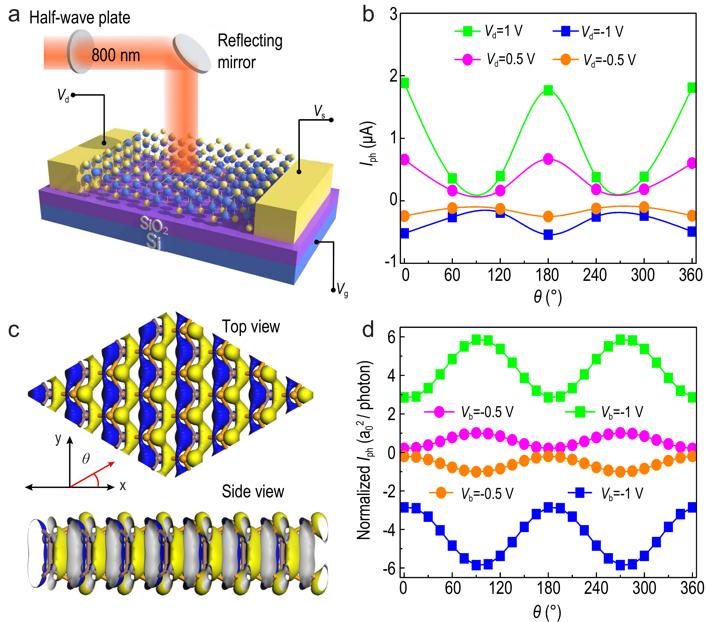
Credit: @Science China Press
To extract the polarization information of incident light, polarization-sensitive photodetectors (PSPDs) exhibit significant practical application in both military and civil areas, like bio-imaging, remote sensing, night vision, and helmet-mounted sight for fighter plane. Optical filters combined with polarizers are usually needed for traditional photodetectors to realize polarized light detection. But it will increase the size and complexity of devices. To obtain a small-size PSPD, one-dimensional (1D) nanomaterials with geometrical anisotropy, such as nanowires, nanoribbons, and nanotubes, have been used as the sensitive materials for PSPDs, which can directly identify the polarization information of incident light without any optical filters and polarizers. However, it is not an easy task for patterning and integrating these 1D nanochannels for mass production of PSPDs.
Atomically layered two-dimensional (2D) semiconductors with low crystal symmetry show great potential in micro-nano PSPDs recently due to their intrinsically in-plane anisotropic properties. For example, SnS, ReS2, GeS2, GeAs2, AsP and black phosphorus (BP) exhibit an obvious in-plane anisotropy behavior in carrier transport, thermal conductivity, electrical conductivity, thermoelectric transport and optical absorption processes. They have potential applications in polarization sensitive photodetectors, polarization ultrafast lasers, polarization field effect transistors and polarization sensors. Among them, BP-based PSPDs have the highest photocurrent anisotropy ratio of 0.59, benefitting from its high carrier mobility and the strong in-plane anisotropy coming from the low-symmetry puckered honeycomb crystal structure. But BP-based optoelectronic devices are hard to get rid of the ambient degradation problem. 2D layered indium selenide (InSe), which also has high carrier mobility and is more stable than BP in atmospheric environment, exhibit huge potential application in high performance optoelectronic and electronic devices. In addition, the anisotropic optical and electronic properties of 2D layered InSe have already been demonstrated in 2019. Worth noting that InSe crystal has three specific polytypes, which are in β, γ, and ε phases, respectively. Among them, InSe in γ-phase and ε-phase belong to symmetry groups. Only the InSe in β-phase (β-InSe) belongs to the nonsymmetry point group, indicating that β-InSe exhibits better anisotropic optoelectronic properties than the other two polytypes.
In order to achieve high performance PSPDs with good stability, the advanced optoelectronic devices research team led by Professor Han Zhang from the Shenzhen University prepare the stable p-type 2D layered β-InSe via temperature gradient method. The anisotropic nature of the β-InSe has been revealed by angle-resolved Raman. The intensity of the out-of-plane and in-plane vibrational modes exhibit pronounced periodic variations with the polarization angle of the excitations. Besides, a good stability of β-InSe flakes and their FET devices has been proved by long-time AFM measurement and multi-repeat electrical performance test. The experimental results (a-b) are in good agreement with the theoretical calculations (c-d) that there are strong anisotropic transport and polarization-sensitive photoresponse in 2D layered β-InSe flakes. The photocurrent anisotropic ratio of the β-InSe photodetector reaches 0.70, which is ranking high among the single 2D material based PSPDs. The strong anisotropic Raman, transport and photoresponse properties of the β-InSe enable its great application potential in filter-free polarization sensitive photodetectors.
###
This research received funding from the National Key Research and Development Project, the National Natural Science Foundation of China, the Natural Science Foundation of Guangdong Province for Distinguished Young Scholars, the Innovation Team Project of Department of Education of Guangdong Province, the Science and Technology Innovation Commission of Shenzhen, and the Scientific Research Fund of Jilin Provincial Education Department.
See the article:
Zhinan Guo, Rui Cao, Huide Wang, Xi Zhang, Fanxu Meng, Xue Chen, Siyan Gao, David K Sang, Thi Huong Nguyen, Anh Tuan Duong, Jinlai Zhao, Yu-Jia Zeng, Sunglae Cho, Bing Zhao, Ping-Heng Tan, Han Zhang, Dianyuan Fan
High performance polarization sensitive photodetectors on two-dimensional β-InSe
Natl Sci Rev nwab098
https:/
Media Contact
Han Zhang
[email protected]
Original Source
http://doi.
Related Journal Article
http://dx.





